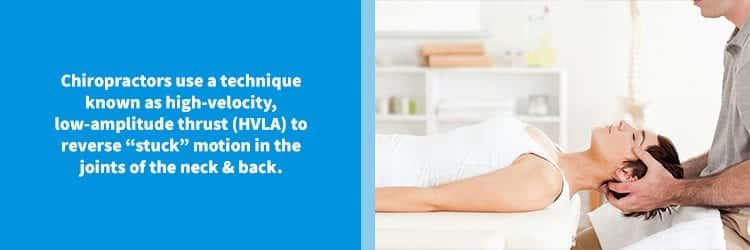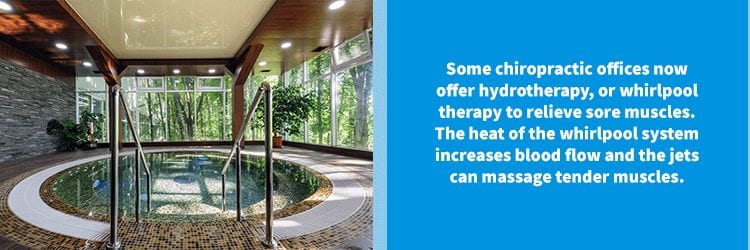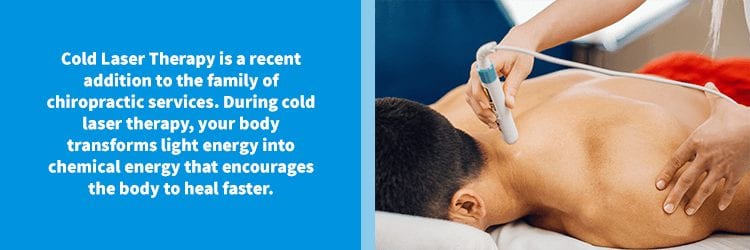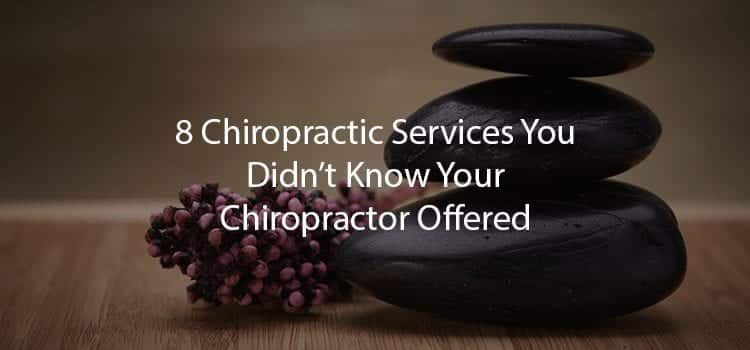What Does A Chiropractor Do For Lower Back Pain?
Doctors of Chiropractic Medicine (DCs) don many different hats during the course of their careers. However, for most of us, going to the chiropractor means one thing: having our necks, backs, and hips adjusted.
During a chiropractic adjustment, a DC uses spinal manipulation to realign the bones and joints of our backs. This means that the chiropractor uses his or her hands to deliver a high-velocity, low-amplitude thrust (or HVLA) to our spines. Although applying force to a sore joint may seem counterintuitive, chiropractors are trained to dislodge “stuck” joints. And, what’s more: they can restore these frozen joints without causing further injury to our backs.

In addition, your DC can use HVLA to treat a variety of disorders that affect your skeletal, muscular, and nervous systems. For example, some of these neck and back issues include:
- Sports Injuries: Chiropractic care can be used to treat a wide array of sports injuries, including torn muscles, strained tendons, and/or sprained ligaments.
- Whiplash: DCs treat many different injuries that affect the spine, but one of the most common is whiplash. Whiplash injuries occur when a collision, such as a car accident, causes the head to whip back and forth on the axis of the neck.
- Migraines: These intense headaches often stem from neck pain and respond well to chiropractic treatment.
- Sciatica: A form of pinched nerve, sciatica often results from improper alignment of the lumbar spine. DCs use HVLA to reverse or ease sciatica symptoms, such as leg pain.
- Myofascial Pain: This disorder occurs when the fascia that bounds your muscles together becomes inflamed, causing painful “knots” or “adhesions” to form in the muscle. If you develop this syndrome, then you might need a chiropractor to release these “trigger” points.
…Among many more!
Aside from Adjustments… What Does a Chiropractor Do?
But, when it comes to chiropractic care, HVLA merely scratches the surface of what your DC can do. For example, in addition to adjustments, some DCs also provide:
Simple Therapies for Muscle Pain
- Hot & Cold Therapy: Many joint injuries, as well as arthritis, heal fastest when alternating rounds of hot & cold therapy are applied. As such, your DC may use ice packs to reduce local swelling or inflammation, before switching over to heat. In contrast, heating pads or wraps serve to increase (instead of reduce) blood flow. This method draws white blood cells with healing factors to the target area.
- Massage Therapy: Before attempting HVLA, your DC may use massage therapy to loosen up your muscles and prevent injury. In addition, your chiropractor may employ a licensed massage therapist (MT) on site. A certified MT may offer more advanced techniques, like myofascial release or hot stone massage.
- Hydrotherapy: You don’t have to go to a spa anymore to get your hydrotherapy fix. Many chiropractic offices now offer whirlpool therapy for patients with sore muscles, arthritis, or paraplegia.

Bring on the Machines!
- Electrotherapy: During electrotherapy, your DC will place a sticky pad containing an electrode over a painful area in your neck and back. When your DC turns the machine on, a gentle buzz of electricity will be sent through the back. Electrotherapy units, like TENS, can be used to reduce muscle spasms, relieve pain, and nurture bone regrowth–among other uses!
- Ultrasound Therapy: Ultrasound therapy uses vibrations from sound to create heat deep inside your muscles. This heat serves to increase blood flow and relax the muscles. You can think of ultrasound therapy as combining the best worlds of heat therapy and massage.
- Cold Laser Therapy: Cold Laser Therapy uses light energy to activate receptors that are found on the surface of our cells. Our bodies then recycle this light energy into chemicals that can speed up the healing process. Used to treat a variety of conditions from knee pain to carpal tunnel syndrome, cold laser therapy is becoming a mainstay in chiropractic care.
- Traction: DCs use traction to relieve pressure on the spine and decompress pinched nerves. During traction therapy, your DC will use mechanical methods, like pulleys or slings, to stretch your spine. This is particularly effective for patients with degenerative disc disease or bulging discs.

Preventative Care
- Lifestyle Education: Not only do chiropractors offer each of the services outlined above (…plus many more!), but they also serve as lifestyle coaches and ergonomic experts. Needless to say, many of the aspects in our daily lives–including our diets, posture, and exercise habits–could use a little TLC. (In fact, weight gain and poor posture at work are leading causes of back and neck pain!) DCs provide diet advice, strengthening exercises, and those much-needed tips for reconfiguring your office.

Looking for simple, pain-free solutions to neck and back pain? Consider visiting your local chiropractor. However, don’t forget to consult with a board-certified orthopedist who can serve as your home base. A qualified physician can guide you through the many phases of the recovery process–and help you get your life back!

